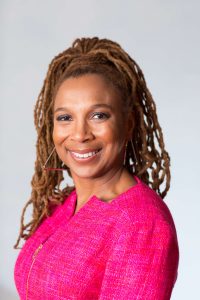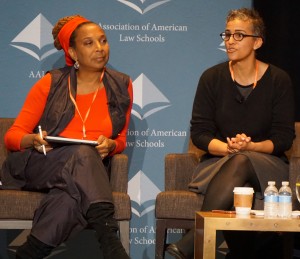It is impossible to separate Professor Crenshaw’s incredible contributions to legal education and the law from the unusual context that now surrounds them. Crenshaw is in a truly singular position.
Both of the academic concepts she is best known for have traveled outside of scholarly circles, entered the mainstream consciousness, and become our everyday language. In the case of intersectionality, the adoption has been relatively seamless. Even outside the context of legal scholarship, viewing the world through a prism of overlapping and compounding identities is a relevant and useful tool.
The same cannot be said for critical race theory. In a catastrophic echo of the ways her thinking originally diverged from some of her contemporaries, the phrase has become catch-all shorthand for those who claim that talking about race at all is, in itself, racist.
“It’s being lumped in with all of these stories, some of which are apocryphal, into a moral panic.”
The demonization began in earnest as a direct result of the June 2020 uprising against police-perpetrated racist violence. Lest multiple months of agitation lead to any progress toward dismantling institutionalized white supremacy, in September 2020, then-President Trump issued an executive order banning federal agencies from conducting diversity and inclusion trainings. The order claimed these trainings were “divisive, anti-American propaganda” and specifically cited intersectionality and critical race theory as problematic terms.
Though President Biden’s administration rescinded the order almost immediately upon taking office the following January, the damage was done. By early 2021, politicians and pundits nationwide and beyond had latched onto the words and initiated a concerted, focused effort to censor them. A wave of backlash swept through every level of American education, from kindergarten to university. Parents, incited equally by misguided anger and manufactured panic, forced their way into school business to ensure their children were not being taught critical race theory. Legislatures aggressively pursued options to enact bans at state and local levels. Educators faced serious consequences for using teaching materials that fell outside a set of narrowly-defined parameters.
Shortly after the November 2021 elections, the Virginia gubernatorial race was fresh in Professor Crenshaw’s mind. Republican candidate Glenn Youngkin had—very publicly—denounced critical race theory and galvanized his supporters to crowd their local school board meetings as they sought to outlaw the concept—and, by association, any teaching or investigation of race whatsoever—from school curricula. An escalating series of protests ended with actual fistfights mere days before the election. Then, Youngkin won.
Why is this happening, and is there any use in attempting to set the record straight? “I am asked this question every day,” Crenshaw says. “And every day I have a different answer because it’s a developing story.”
Whereas intersectionality “escaped the law” two decades ago and traveled far and wide to become a commonly-used concept in multiple other disciplines, critical race theory did not. “It became popularized,” Crenshaw says, “because critics wanted to use it to stoke fear and division. When an idea travels not because people are engaging with the ideas but because they are trying to appropriate the geography and repopulate it with their own ideas, then you have trouble.”
“It’s not as if I can just go clear this up, or even have a debate. Critical race theory is a prism and a set of questions to be asked and applied to a wide variety of contexts. The current crisis is not an engagement of ideas. It’s an effort to attach a term that people don’t know about to fears that they are fully in touch with.”
“It’s using a legislative approach to shut down both subject matters and viewpoints about those subject matters…that’s not free thinking. That’s not inquiry. That’s about power.”

 The winner of the sixth AALS Triennial Award for Lifetime Service to Legal Education and to the Law needs no introduction. The Association is proud to award this honor to Professor Kimberlé Crenshaw.
The winner of the sixth AALS Triennial Award for Lifetime Service to Legal Education and to the Law needs no introduction. The Association is proud to award this honor to Professor Kimberlé Crenshaw.